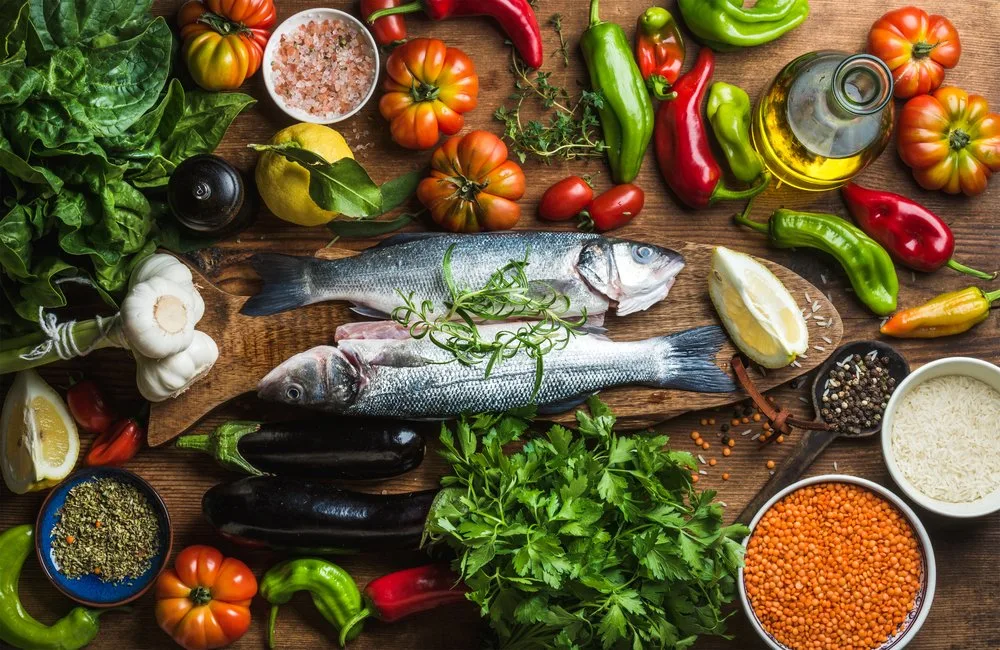Last year, the DASH diet was ranked as the second-best diet overall by U.S. News and World Report, after the Mediterranean diet. It was the first time the diet held the number 2 spot, as in 2018 it held the number one spot – a position it had held for eight consecutive years. The reason for this? Well, the DASH diet has become one of the most effective ways to address high blood pressure, helping to combat the growing threat of hypertension.
According to statistics from the World Health Organization, around 1.13 billion people worldwide are currently battling hypertension. As hypertension can increase the risk of memory loss, stroke as well as a heart attack, it’s important to address the concerns around high blood pressure as soon as possible. Considering the fact that dietary intake is one of the biggest risk factors for high blood pressure, scientists have devised a dietary plan that can help to reduce blood pressure and protect your health.
What is the DASH diet?
The DASH in the DASH diet is an acronym for Dietary Approaches to Stop Hypertension and, as the name suggests, the eating pattern is aimed at reducing high levels of blood pressure. It does this by
focusing on portion size, as well as encouraging the consumption of a wide variety of foods, rich in essential nutrients. These foods include fruits and vegetables, low- or non-fat dairy foods, legumes, and nuts.
In particular, the diet encourages one to cut back on their intake of sodium, or salt, and sugar all whilst increasing their intake of magnesium, calcium, and potassium – three nutrients that have been found to effectively lower blood pressure. The diet program advises no more than 1 teaspoon (2,300 mg) of sodium per day (which is also the recommended sodium intake), with the lower-salt version of the diet recommending no more than 3/4 teaspoons (1,500 mg) of sodium per day.
The idea behind the diet was developed around a study originally published in 1997 in the New England Journal of Medicine. The study set out to examine the impact of diet on blood pressure, and according to the findings, the researchers discovered that the DASH diet was quite effective in dropping blood pressure levels, especially when compared to the two other diets.
Now, while the DASH diet is specifically designed to help lower blood pressure, you’ll be happy to know that it also provides a wide range of additional health benefits that will serve to make 2020 your healthiest year yet.
Health benefits of the DASH diet
1. Effective at treating hypertension
Blood pressure refers to the force put on your blood vessels and organs as your blood passes through them. It’s counted in systolic pressure (the pressure in your blood vessels when your heart beats), and diastolic pressure (the pressure in your blood vessels between heartbeats, when your heart is at rest).
Healthy blood pressure is a systolic pressure below 120 mmHg and a diastolic pressure below 80 mmHg, read as 120/80. A blood pressure reading of 140/90 is considered too high.
Over the years, various studies have demonstrated how effective the DASH diet is at lowering blood pressure.
For instance, a study published in Hypertension found that after following the DASH diet for 8 weeks, patients with pre-hypertension and hypertension each experienced a drop in both systolic blood pressure and diastolic blood pressure.
2. Improved bone health
Through the foods that it encourages for consumption, the DASH diet can also help to protect bone health, by reducing the risk of osteoporosis.
How so? Well, the DASH diet encourages the consumption of dairy products and green leafy vegetables – both of which are rich in calcium. What’s more, research published in the Journal of Nutrition found that the DASH diet can help to significantly reduce bone turnover which, if sustained, may help to improve bone mineral status.
3. Reduced cancer risk
As the DASH diet advocates for a high intake of fresh fruits and vegetables, which are incredibly high in nutrients and antioxidants, it’s safe to say that the diet can help to lower the risk of some cancers. Furthermore, the diet also recommends reducing the intake of red meat, which has been linked to early death, as well as cancer.
 What’s more, a 2015 review published in the Journal Of Research In Medical Sciences found a strong correlation between the DASH diet and a lower risk of some cancers, including colorectal and breast cancer.
What’s more, a 2015 review published in the Journal Of Research In Medical Sciences found a strong correlation between the DASH diet and a lower risk of some cancers, including colorectal and breast cancer.
4. Reduced diabetes risk
Insulin resistance is often a precursor to type 2 diabetes. However, the DASH diet may help lower the risk of type 2 diabetes as it’s been found to help to prevent insulin resistance.
The study, published in the Current Hypertension Reports, revealed that the DASH eating plan was effective at improving insulin resistance.
5. Lowers risk of heart disease
Yes, the DASH diet does help to normalize blood pressure levels, but it’s important to remember that a reduction in blood pressure does not always translate to a reduced risk of heart disease. That said, studies have shown that the DASH diet can help to reduce the risk of heart disease as it helps the heart to function more effectively and efficiently, regardless of whether you struggle with high blood pressure.
For one, the DASH diet encourages the intake of fruits and vegetables, whole grains, and legumes – all of which are incredibly high in fiber. As a result, high levels of fiber can help to protect cardiovascular health by improving cholesterol levels.
As such, a 2019 study published in the American Journal of Preventive Medicine found that patients below the age of 75, who had followed the DASH diet, experienced a significantly lower risk of heart failure when compared to the study participants who did not follow the DASH eating plan.
6. Improved brain function
Close to 50 million people worldwide are currently living with Alzheimer’s. However, the DASH diet may help to reduce the risk of mental decline.
According to research presented at the Alzheimer’s Association 2009 International Conference on Alzheimer’s Disease, high blood pressure is often cited as a risk factor for the development of neurodegenerative diseases like Alzheimer’s and dementia. That said, the team that presented the findings conducted a study that suggested following the eating plan would have neurological benefits.
Eating on the dash diet
One of the best things about the DASH diet is the fact that the recommended foods readily available for most people. That said, below is a list of foods that one is encouraged to eat whilst on this diet.
1. Whole grains ( 6–8 Servings per Day)
Whole grains, which include brown bread, brown rice, quinoa, oatmeal, and millet. Unlike their processed counterparts, whole grains are free of any detrimental elements and instead, are packed with fiber and potassium. These grains will help to reduce your risk of high blood pressure, keep you full between meals, and even reduce your risk of diabetes.
2. Fruits (4–5 Servings per Day) 
There’s a lot of fruit when it comes to the DASH diet. This is probably due to the fact that bananas, apples, and citrus fruits like oranges and limes, contain potassium – a mineral that is effective at helping to lower blood pressure.
What’s more, anthocyanin, which is a phytonutrient responsible for giving fruits like blueberries, raspberries, and strawberries their bright hues, has also been linked to helping to protect against high blood pressure.
3. Vegetables (4–5 Servings per Day)
Vegetables contain both fiber and phytonutrients – both of which can lead to significant reductions in blood pressure.
4. Dairy (2-3 servings a day)
Rich in both potassium and magnesium, dairy products can help protect against the risk of high blood pressure. It would be advisable to opt for low-fat or non-fat dairy products – just be sure that there are no added sugars or preservatives.
5. Poultry, fish, and lean meats (6 or Fewer Servings per Day)
Lean meats are rich in B vitamins, vitamin E, magnesium, iron, zinc, and protein – all of which can help protect your overall health, as well as reduce the risk of hypertension.
These meats, such as boneless, skinless chicken breasts, and turkey cutlets have a lower fat content, yet are quite high in the above-mentioned nutrients. Additionally, fish such as tuna, mackerel, sardines, and salmon contain monounsaturated and polyunsaturated fats, as well as omega-3 fatty acids, making them the perfect addition to your heart-healthy diet.
6. Legumes, seeds, and nuts (1-2 a day)
Similar to fish, nuts are also rich in omega-3 fatty acids. Both nuts and legumes also contain healthy amounts of fiber. Additionally, legumes, including beans, lentils, and peas, also contain magnesium and potassium, as well as protein and fiber.
With that said, it’s clear that this particular food group can effectively help to reduce the risk of high blood pressure.
7. Oils: (2–3 Servings per Day)
If you’re looking to use oils on the DASH diet, it would be advisable to go for healthy oils such as olive oil, canola oil, and safflower oil.
What about my salt?
Are you someone who is used to adding a lot of salt to their foods to enhance the flavor? If so, you can opt for lemon or lime juice, and chopped fresh or dried herbs. Additionally, you can also use cinnamon as well as garlic to add flavor to your foods.
Foods to avoid
As sodium lurks in unlikely places, it’s important to become an expert at reading food labels. Additionally, it would be advisable to stay clear of the following foods; 
- highly processed foods with added sugar such as candy, chips, and pastries
- High-fat snacks
- Sodas and other sugary beverages
- Salad dressings
- Cheese
- Sauces and gravies
- White bread and rolls
Conclusion
At the start of the new year, it can be quite challenging to adjust one’s eating habits. However, adopting the DASH diet will have a great impact on your health. That said, it’s best to start small when it comes to following this diet.
Additionally, one should remember that a healthy lifestyle doesn’t just stop at your diet. If you really want to enjoy a healthy 2020, then you should get plenty of exercise, moderate your alcohol intake (a glass a day), and quit smoking.
References
Adler AJ, Taylor F, Martin N, Gottlieb S, Taylor RS, Ebrahim S. (2014), Reduced dietary salt for the prevention of cardiovascular disease. Cochrane Database of Systematic Reviews, Issue 12. Art. No.: CD009217. DOI: 10.1002/14651858.CD009217.pub3.
Conlin, P & Chow, D & Miller, E & Svetkey, L & Lin, Pao-Hwa & Harsha, D & Moore, Thomas & Sacks, F & Appel, Lawrence. (2000). The effect of dietary patterns on blood pressure control in hypertensive patients: results from the Dietary Approaches to Stop Hypertension (DASH) trial. American journal of hypertension. 13. 949-55. 10.1016/S0895-7061(99)00284-8.
Hinderliter, A., Babyak, M., Sherwood, A., Blumenthal, J., (2010). The DASH diet and insulin sensitivity. Current hypertension reports. 13. 67-73. 10.1007/s11906-010-0168-5.
Lin P.H, Ginty F, Appel L.J, et al, (2003), The DASH Diet and Sodium Reduction Improve Markers of Bone Turnover and Calcium Metabolism in Adults, The Journal of Nutrition, Volume 133, Issue 10, Pages 3130–3136, https://doi.org/10.1093/jn/133.10.3130
Moore, T., Conlin, P., Ard, J., Svetkey, L. (2001). DASH (Dietary Approaches to Stop Hypertension) Diet Is Effective Treatment for Stage 1 Isolated Systolic Hypertension. Hypertension. 38. 155-8. 10.1161/01.HYP.38.2.155.
Onvani, S., Haghighatdoost, F., Azadbakht, L., (2015). Dietary approach to stop hypertension (DASH): Diet components may be related to lower prevalence of different kinds of cancer: A review on the related documents. Journal of Research in Medical Sciences. 20. 708-713. 10.4103/1735-1995.166233.




![women [longevity live]](https://longevitylive.com/wp-content/uploads/2020/01/photo-of-women-walking-down-the-street-1116984-100x100.jpg)










